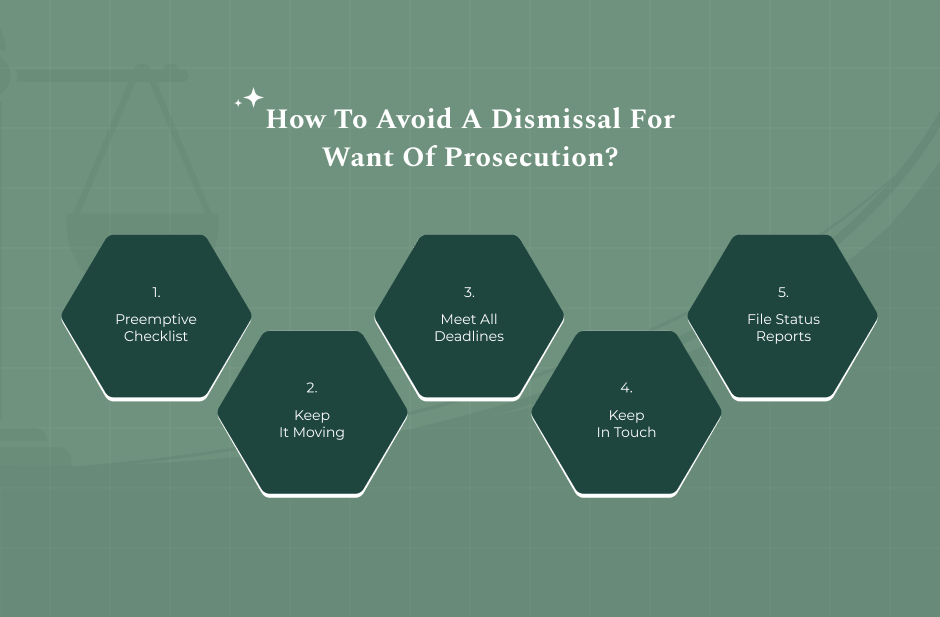Litigation takes time. But courts cannot permit cases to continue indefinitely. All legal systems depend on rules that impose a requirement of forward motion.
When one party like the plaintiff is too slow or not moving at all, the court may dismiss the lawsuit. That is called dismissal for want of prosecution and it is one of the worst things that can happen to a plaintiff.
In this article, we explain what ‘dismissal for want of prosecution’ means, why judges invoke this power, and what steps you must take in order to protect your case.
We go on to outline the core legal principles involved before providing actionable advice for both plaintiffs and defendants from all over the world.
What Is Dismissal For Want Of Prosecution?

A dismissal for want of prosecution is a court-ordered termination of a lawsuit. The court imposes this penalty because the plaintiff has failed to pursue their case diligently. The operative word here is diligently.
The dismissal does not hang on whether the underlying claim is substantially meritorious or not. This is simply about how the plaintiff conducted himself during the litigation process.
The Core Concept- Inactivity And Non-Compliance
The general legal rule is that courts have inherent authority to control their dockets. That power is necessary so the courts can dispense justice without delay to all litigants. If a plaintiff allows his case to languish, that case clogs the court system. Inactivity wastes judicial resources.
“The court will consider factors such as the length of the delay, the reasons for the delay, and any prejudice caused to the defendant,” according to Clio.
A judge will usually grant a dismissal for want of prosecution in scenarios where one or more of the following situations occur:
Failure To Appear
A plaintiff or their attorney fails to appear during a hearing, a status conference, or their trial date.
For an extended period of time, no discoverable activity-like the taking of discovery, issuance of a subpoena, or filing a motion, has been taken by the plaintiff for several months or longer.
Non-Compliance With The Court Orders
The plaintiff continued to disregard the deadlines posed by the judge for initial disclosures and reports that needed to be filed.
Dismissal is a penalty. Dismissal punishes a party that causes a delay.
Receiving An Order Of Dismissal For Want Of Prosecution
A court may enter an order of dismissal for want of prosecution in either of two ways. First, the court may act sua sponte. This happens where the court, on its own motion, notices a long period of time has passed without action and serves notice of intent to dismiss.
Alternatively, the court may grant the defendant’s formal motion. The defendant moves the court to dismiss the case because of the plaintiff’s neglect to prosecute the suit. Either way, this final order of dismissal for want of prosecution dismisses the suit.
The Court’s Checklist- Criteria For Dismissal

Before entering a dismissal for want of prosecution, judges do consider several critical factors. Thus, in weighing these interests, a judge must balance the plaintiff’s right to be heard against the defendant’s right to a timely resolution and the court’s interest in efficiency, as per the Speedy Trial Act (CPL 30.30) and People v. James (2017).
Inactivity Or Delay- The “Too Long” Question
The first is the length of the delay. How long is too long will, of course, depend on the jurisdiction and the complexity of the case. In some US states, local rules provide for a fixed period of inactivity, for example, 180 days-triggering review. In common law jurisdictions, the test is less rigid.
Inexcusable Delay- When Excuses Are Not Enough
The court looks at the cause of the delay. If the plaintiff is able to show a good, reasonable cause-such as serious personal illness, death of an essential witness, or a delay in receiving documents not within the plaintiff’s control-the delay may be excusable.
However, if the plaintiff is only able to show simple neglect, forgetfulness, or mismanagement, the delay is generally not excusable. Prior history of extensions makes it more difficult to establish the excuse.
Prejudice To The Defendant- The Fairness Test
This would be a relevant factor, taken into consideration particularly in jurisdictions other than the United States. The courts would inquire: Has the delay caused any specific, tangible harm to the defendant’s ability to defend the case? This is known as prejudice.
Examples of prejudice include:
- Key witnesses die or otherwise become unavailable.
- Physical evidence is lost or deteriorates.
- The memory of a witness considerably fades with time.
- There are extra costs incurred by the defendant because of delays and uncertainties of the case.
Where the defendant is able to show that he is suffering irreparable prejudice as a result of delay, a dismissal for want of prosecution becomes far more probable.
Consequences- With Prejudice Vs. Without Prejudice
The most important feature of any order dismissed for want of prosecution is whether such is “with prejudice” or “without prejudice.”
Dismissal “With Prejudice”
Dismissal with prejudice is the worst possible scenario for the plaintiff. That means the plaintiff can never re-file the suit based upon the same claim or facts against this defendant. The case is permanently terminated.
The underlying claim is lost forever, no matter how strong it originally was.
Dismissal “Without Prejudice”
A dismissal without prejudice is a serious warning yet offers a lifeline in that the plaintiff can refile the lawsuit.
Sometimes this is only possible if the statute of limitations has not expired, though. When the time limit to file has passed, then even a dismissal without prejudice becomes permanent.
To the defendant, a final order of dismissal for want of prosecution is a big relief.
It relieves the burden that the suit posed on the defendant, and they often recover costs of litigation from the plaintiff.
Jurisdiction Spotlight- Rules Around The World
The rules of dismissal for want of prosecution apply variably from place to place, and while the main idea is the same, the thresholds differ.
The American Approach
In the United States, rules determining dismissal for want of prosecution are for the most part left to the individual states or local federal courts. For example, dismissal for want of prosecution in Texas is controlled by specific state civil procedure rules.
Texas Rule of Civil Procedure 165a allows the court to dismiss the case on notice if a plaintiff fails to appear at a hearing or no action has occurred within a prescribed time. The rules are generally strict and associated with docket efficiency.
UK And Irish Common Law
The common law test in Ireland and the UK is generally based upon the standard of ‘inordinate and inexcusable delay’.
More recently, the Irish Supreme Court has sought to reframe the principles so as to emphasise the two-and four-year periods of inactivity as thresholds at which more significant justification on the part of the plaintiff is required as time increases. Canadian courts apply this approach. Frequently, the dismissal for want of prosecution is considered to be a draconian remedy that is rarely employed.
Does The Rule Apply To Criminal Cases?
Though the rule essentially applies to civil suits, the principle does exist in criminal or quasi-criminal contexts as well. For instance, in countries like India, the rule can be invoked, if a complainant has failed to appear to prosecute a private criminal complaint.
Action Plan For Complainants: How To Avoid A DWOP

The best defense against dismissal for want of prosecution, if you are a plaintiff, is vigilance.
Preemptive Checklist
Keep your case active. Don’t wait for the court to remind you.
Keep It Moving
Regularly schedule and conduct discovery, including even minor steps such as serving requests for production.
Meet All Deadlines
Court-imposed deadlines supersede all other deadlines.
Keep In Touch
Let your attorney be updated about every step so that communication continues.
File Status Reports
If your case stalls, file a short status report explaining why and what the next step will be.
Delay In Documents
Where the cause of the delay is beyond your control, write to the court and the defendant as soon as possible.
If You Face A Motion
If the defendant or the court moves to dismiss for want of prosecution, you must quickly and effectively respond. In that response, you must show:
Explanation
Reasons for the delay are to be clearly explained.
No Prejudice– Argue that Appellant was not prejudiced by the delay.
Future Diligence– Submit a proposed calendar showing specific steps you will undertake forthwith to bring the case to trial.
Motion To Dismiss- Action Plan For Defendants
A defendant may capitalize on the rule relating to dismissal for want of prosecution in gaining an early victory.
When To Raise A Motion To Dismiss
Carefully review the case history. The best time to file a motion to dismiss for want of prosecution is immediately after a lengthy period of documented inactivity on the part of the plaintiff.
How To Build Your Argument
Your motion should be based on two key arguments:
1. Inactivity
Document the instances when the plaintiff has not acted or has failed to meet deadlines.
2. Prejudice
You must show that the delay has prejudiced your ability to defend the case. For instance, state that an important witness relocated, or that the continued defense costs have become oppressive.
Keep in mind that courts prefer to decide cases on the merits, if possible. You will have to make an adequate showing of both inexcusable delay and clear prejudice before you can succeed in getting a final order of dismissal for want of prosecution.
Success In Litigation- Expert Tips
The mastery of the rules relating to dismissal for want of prosecution provides the backbone for any litigation strategy.
Keep case management spreadsheet on key dates up-to-date at all times.
For Defendants
Don’t let the plaintiff coast. Procedural rules can be used to force action.
Early in the case, plaintiffs must submit a case management plan to the court.
If settlement discussions indicate that a settlement may be possible, ask the court to enter a brief stay of the proceedings which formally excuses inactivity.
In court, the general rule is that the courts want to hear a case, so at every opportunity, seek to show a judge that you will move expediently.
Read Also: Detention Hearing Explained – Purpose, Procedure & What To Expect
Frequently Asked Questions (FAQs):
Take litigation deadlines seriously, whether you are a plaintiff or a defendant. Understanding the possibility of your case being dismissed for want of prosecution would protect your legal rights.
Generally speaking, two basic examples would probably result in a dismissal due to lack of prosecution.
First, the court could find a period of at least six months when no filings or action occurred. Second, a motion filed by the defendant may bring to the attention of the court the plaintiff’s non-action.
The most important trigger is some evidence that the plaintiff is not demonstrating reasonable efforts to move along the case, out of concern for court productivity.
Yes, it might. It could be refilled if the statute of limitations allows, in the event the dismissal was without prejudice.
A case is over if the dismissal was with prejudice. A plaintiff may also file a motion to reinstate the case shortly after the order of dismissal for want of prosecution is issued. To do this, the plaintiff must show there was “good cause” for the delay and that he now intends to move forward with appropriate diligence.
They are fundamentally different. A dismissal for want of prosecution is a procedural termination. The court never examines the facts or the evidence.
Thus, a case is terminated solely because the plaintiff has failed to take the procedural steps necessary to move the litigation forward. A summary judgment, by contrast, is a decision on the merits. The court considers the motions and supporting materials offered by the parties and determines that one party must prevail.

















